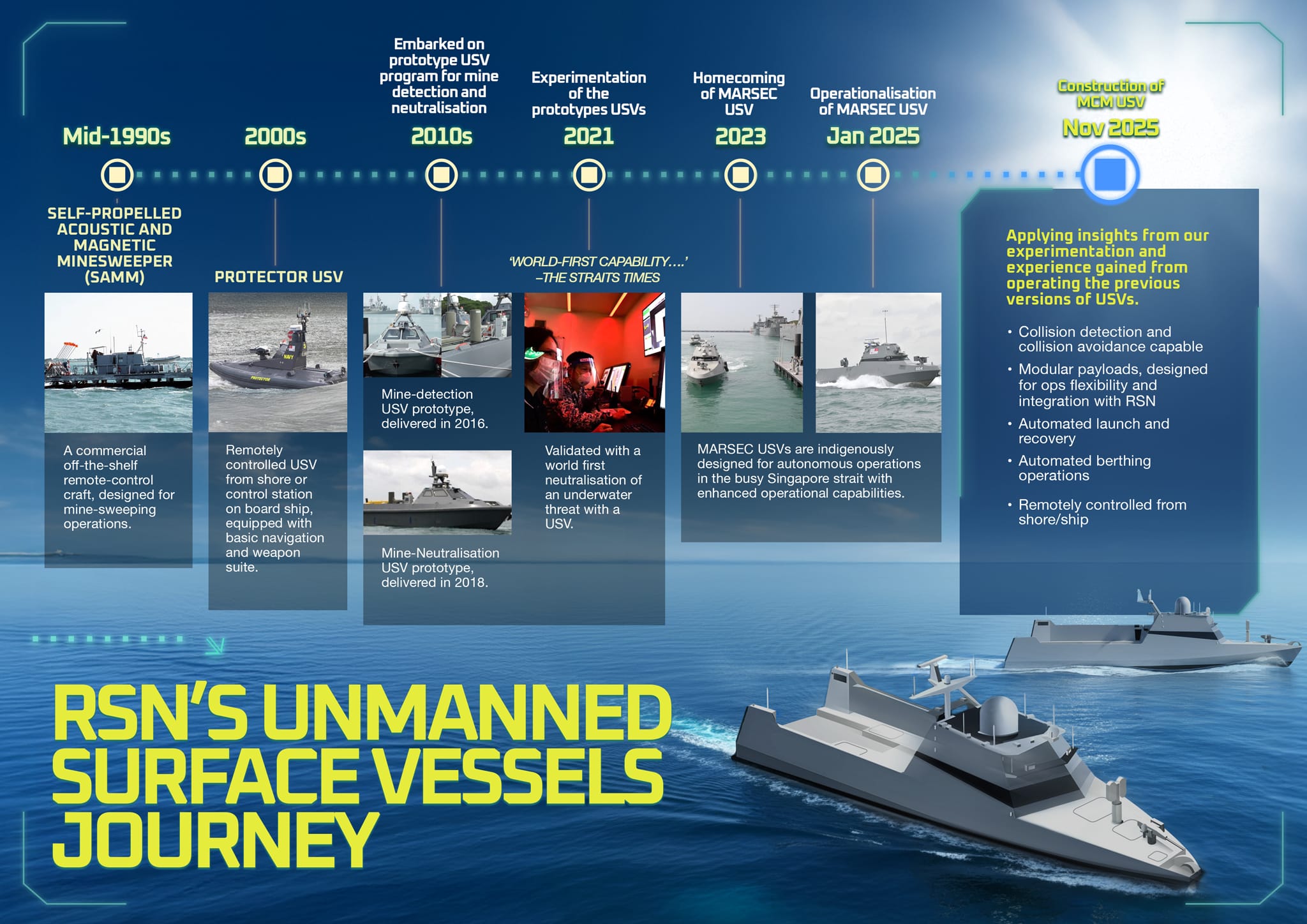- Home
- News and Events
- Pressroom
- RSN Begins Construction of Mine Countermeasures Unmanned Surface Vessels (MCM USV)
RSN Begins Construction of Mine Countermeasures Unmanned Surface Vessels (MCM USV)
13 November 2025

The RSN’s Unmanned Systems journey began in the 1990s with the acquisition of commercial-off-the-shelf remote-controlled Self-propelled Acoustic and Magnetic Minesweeper (SAMM) and the Protector USV for base security. With advancements in technology and increasingly complex mission demands, the RSN explored new use-cases and started experimentation and development of purpose-built unmanned systems.
This led to the development of indigenous prototype USVs for mine detection and neutralisation since 2012. Such efforts included our experimentation to “unman” the Towed Synthetic Aperture Sonars (TSAS) payload with USV operations, followed by a first-in-the world unmanned Mine Neutralisation System (MNS) firing in 2021, which validated that the USVs can be deployed to identify and neutralise underwater threats. Insights gained from experimenting with these prototypes then continued to shape the development of our Maritime Security (MARSEC) USVs, including the development of the Collision Detection and Collision Avoidance (CDCA) algorithm to enable the USVs to operate safely in the busy Singapore Strait. The MARSEC USVs were deployed for operations in the Singapore Strait since Jan 2025.
Around the world, modern navies are shifting to the deployment of unmanned MCM systems as solutions to achieve mission requirements amidst competing demands for manpower, speed and safety(1). The RSN remains committed to explore more efficient and safer ways to conduct MCM operations.
The MCM USVs will operate as part of the RSN’s suite of enhanced MCM capabilities, that includes Autonomous Underwater Vehicles (AUVs), minesweeping systems, command and control (C2) and maintenance infrastructures. Each USV can deploy a Towed Synthetic Aperture Sonar (TSAS) to survey and detect underwater threats, or Mine Neutralisation System (MNS) to identify and neutralise these threats.
Heightened Operational Flexibility
Given the range of missions that the RSN undertakes, the USVs are designed for operational flexibility, where it facilitates rapid reconfiguration when required. For instance, the USV can be configured with either the Towed Synthetic Aperture Sonar (TSAS) for seabed survey, or Mine Neutralisation System (MNS) for identification and neutralisation. Equipped with a suite of electro-optical system, gun, and less-lethal weapon systems, the MCM USVs can also be rapidly re-rolled for other maritime security tasks when required. The commonality in the design and maintenance of these USVs also further optimises the operational flexibility with quicker turnarounds.
Improved Operational Efficiency
The MCM USVs would enable a new and more efficient MCM operating concept, where the USVs can be configured to take on either the “sensor” or “shooter” role. These USVs could be deploy for simultaneous survey or neutralisation operations, which would enable significant savings in the traditionally time-consuming MCM operations performed sequentially by a single MCMV, given that both the “sensor” and “shooters” are tethered to the same ship.
Traditional manpower-intensive crane operations to launch and recover these payloads (minimally 4-5 personnel required) are also replaced with automated launch and recovery systems that are remotely controlled. Additionally, as the USVs would employ automated berthing/unberthing to replace traditional seamanship evolutions, further manpower savings are expected.
Safer and More Manpower-Efficient
With the ability to operate remotely from shore, the MCM USV eliminates the need for personnel to be onboard, keeping them safe from mine threats. Leveraging advanced C3 with automated launch and recovery systems, each USV only requires a small team of operators for remote control and monitoring, vis-à-vis the existing manpower intensive tasks on the MCMV (which requires 30 personnel minimally).
Plate-Cutting Ceremony – A New Milestone
The plate-cutting (more widely known as steel-cutting) ceremony is a traditional milestone to mark the official start of hull construction, where the first plate for the vessel is cut, symbolising the transition from design and planning to actual construction.
With this plate-cutting, the RSN is making steady progress to introducing these MCM USVs from 2027 onwards. These USVs, together with other MCM capabilities, will replace the existing Bedok-class MCMVs and MCM capabilities, enabling the RSN to better safeguard our waters and sea lines of communications.
(1) Established navies like France-UK, Belgium-Netherlands are developing unmanned MCM programmes by leveraging USVs and AUVs.